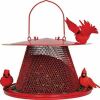
What’s This Post About?
This post will explore the different colors of cardinals and how they get their specific colors. You will learn about which cardinals exist in reality and which cardinals exist only in rumor.
The four possible colors of cardinals will be discussed along with their characteristics and how they get their pigmentation.
Furthermore, you will also find out about what influences this pigmentation and whether or not their bright color is a true indication of their health.
Cardinals exist in red, yellow, white, and golden/brown colors. Many people believe that they have sighted a blue cardinal however, they do not exist. The primary color that cardinals can be found in include red for male cardinals and grey-brown for female cardinals.

How Do Feathers Get Their Colors?
The structural properties and pigments are responsible for creating color in bird feathers. When these two combine, they can create various new colors.
The structural properties basically reflect or scatter light in such a way that it gives colors to the feathers. This mostly makes the blue or iridescence color in birds.
On the other hand, pigments are present in both plants and animals. This substance can be divided into three groups: carotenoids, melanin, and porphyrins.
1. Carotenoids
These are made by plants and can be transferred to birds by eating plants or by consuming another creature that ate plants. Carotenoids make colors like red, orange, or bright yellow. They can also combine with melanin to make beautiful colors like olive green.
2. Melanin
Melanin is also found in humans and is responsible for our skin and hair color. It makes various colors ranging from black to brown and even reddish browns. Melanin also helps feathers remain in good shape as it makes them sturdier and stronger.
3. Porphyrins
Porphyrins are rarer than the other two and can only be found in a handful of bird species. This pigment is created when amino acids are modified. It makes many colors like red, pink, and green.
These three pigments, along with the structural properties of birds, are how birds get their colors.

Red Cardinals
The northern cardinals get their red coloring from carotenoids. They eat parts of plants such as fruits or seeds which are rich in carotenoid pigment.
When this food metabolizes, it goes through the liver and the bloodstream which then deposits it to the growing feather follicles.
The new feathers that grow on the cardinals are then brighter and richer in color. The already existing feathers on the cardinals are not influenced, only the new ones are.

The color vibrancy of these red cardinals depends completely on their diet. If they eat food with a lower amount of carotenoids then the cardinal’s color begins to pale and fade.
On the contrary, food that is rich in carotenoids will make their feathers brighter.
Male Cardinals and Their Shades of Red
The female cardinals choose their mate depending on the color of their feathers. The male cardinals which have brighter feathers are considered better mates than those with paler ones.
When a male cardinal is bright red that means he has access to good food which is rich in nutrients and carotenoids.
Female cardinals consider them fit and healthy and believe that they will be able to provide them and their young with nutritious food.
Bright red cardinals also have the capability of holding a larger and better territory and even provide more parental care.
Male cardinals which have a dull shade of feathers signify weakness and inability to provide good food and territory to their young.

However, this is not always the case. The correlation between color and fitness isn’t necessarily true. In urban areas particularly, people plant non-native Amur honeysuckle which cardinals like to eat.
This honeysuckle has high carotenoids but is low in nutrients and minerals. It signifies that these birds will be bright red but still won’t be healthy.
The opposite happens with sunflower seeds. People put sunflower seeds in their bird feeders and although it is high in nutrients, it has a low quantity of carotenoids which results in a healthy cardinal with pale feathers.

Brown Cardinals
While male cardinals are red, female cardinals are mostly brown in color. They have the same black-colored face and red-orange bill, but their body is a lighter shade of brown with slight hues of red.
Female cardinals are brown so it helps them hide from predators and they can easily camouflage themselves in the trees.
You will mostly see male birds having a brighter color than their female counterparts because they usually use their vibrant feathers to woo their mates.

Yellow Cardinals
Yellow cardinals are extremely rare and the chances of sighting one is very less. In fact, their yellow color is because of a genetic anomaly. They lack the enzyme that turns the yellow dietary pigments to red.
Therefore, they do not have a functional system because of a genetic mutation. Yellow cardinals have been sighted before in states including Alabama, Florida, Georgia, Louisiana, Mississippi, Pennsylvania, and Tennessee.

White Cardinals
Similar to yellow cardinals, white cardinals are also the result of a genetic mutation. They have fewer melanin-producing enzymes due to which their feathers appear white. This condition is known as ‘leucism’.
Typically, you will find partial-albinos because the cardinal’s feathers may mostly be white but they will have a colored crown or dark eyes.
True albino cardinals do not produce any melanin. Their feathers will not have any color and their eyes will be red. Melanin helps birds see better and aids in protecting their eyes against UV rays.
Hence, a true albino may find it difficult to see and therefore live. They can neither camouflage themselves from predators nor can they properly see them.

Do Blue Cardinals Exist?
Despite many people thinking that they have sighted a blue cardinal, they do not exist.
There are several reasons behind why people are convinced about blue cardinals’ existence even though they don’t.
-
People may confuse another bird for a cardinal. It is extremely common for people to confuse one bird with another because a lot of them look quite similar. Birds evolve throughout their lives and it may be difficult to differentiate one from the other. People may think that they have seen a blue cardinal but in reality, it is just another bird.
-
The lighting near the cardinal might be such that it will make the bird appear blue. The paler colored cardinals can be mistaken for a blue one if the area that it is in is giving it a blue tint.
-
Many rumors revolve around the existence of a blue cardinal which may trick people into thinking that they have seen one when they haven’t.
Thus, blue cardinals just exist in rumor and are a myth. For a blue cardinal to even possibly exist, it will take numerous years of evolution.
Attracting Cardinals So That You Can Have a Look at Their Vibrant Colors
In order to attract cardinals, you need to provide a safe area for them with a good food source. You can start by researching about cardinals and whether or not they visit your area.
You will then buy a bird feeder for them and hang it in a safe place, away from predators. This bird feeder will contain all the food sources which will have all the required nutrients for a cardinal’s diet. Explore the Perky Pet feeder for Cardinals.
Perky-Pet C00322 Red Cardinal Bird Feeder
The circular perch and mesh surface provides a large feeding area
It is best to set up multiple bird feeders so that you can create an entire feeding station. This will ensure that the maximum number of cardinals come to you and they feel safe.
The more food that is available, the more incentive they will have to visit your backyard.
You may also create a bird bath so that these birds can quench their thirst and be able to bathe there in the summers.
This will make your yard look extremely attractive for cardinals to visit and then you can have a close look at them and be able to examine their feathers and colors up-close.
To understand how to install a birdbath, read my post.
5 Easy Steps to Install a Bird Bath: Security, Position, Height, and More Tips!
Install a birdbath today and make your lawn, a bird’s gorgeous looking, favorite rest spot. Read more about this garden accessory now!
Keep Reading!
This post by now should have given you a clear and comprehensive understanding of cardinals and their colors. You now know about what determines a cardinal’s color and its vibrancy.
The concept of the structural properties and pigmentation of a cardinal’s feather’s color should be clear to you.
If you wish to know more about cardinals and how long they live, here’s a post you shouldn’t miss out on reading.
How Long do Cardinals Live? The Record is Amazing!
The cardinals are known for their bright red coloration and their crested head. Learn how long they can survive in the wild.

By David A. Swanson
Bird Watching USA
My name is David and I'm the the founder of Bird Watching USA! I started Bird Watching with My father-in-law many years ago, and I've become an addict to watching these beautiful creatures. I've learnt so much over about bird watching over the years that I want to share with the world everything I know about them!

David A. Swanson
Bird Watching USA
My name is David and I'm the the founder of Bird Watching USA! I started Bird Watching with My father-in-law many years ago, and I've become an addict to watching these beautiful creatures. I've learnt so much over about bird watching over the years that I want to share with the world everything I know about them!





![What?! Do Geese Really have Teeth?! [24 Awesome Pictures] Thumbnail](/assets/resized/img/posts/do-geese-have-teeth-100x150.jpg)


![What?! Do Geese Really have Teeth?! [24 Awesome Pictures] Thumbnail](/assets/resized/img/posts/do-geese-have-teeth_thumbnail-100x56.jpg)


